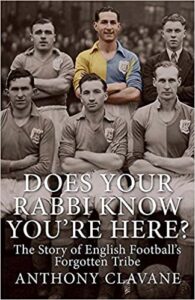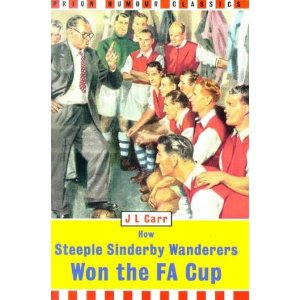Book Review: Does Your Rabbi Know You’re Here? by Anthony Clavane
 When I was growing up, the football book market was pretty much restricted to lazy and often ‘ghosted’ biographies, where ‘the boys done good’ mentality was about as incisive as it got. Thankfully, as the early 1990’s emerged this changed, with books such as “Fever Pitch” by Nick Hornby paving the way for a better expression of the fan experience and the beautiful game in a wider context. Following in this vein Anthony Clavane wrote the Award winning “Promised Land: A Northern Love Story”, which tells the tale of the rise and fall of Leeds United, intertwined with that of the City of Leeds and of the Jewish community.
When I was growing up, the football book market was pretty much restricted to lazy and often ‘ghosted’ biographies, where ‘the boys done good’ mentality was about as incisive as it got. Thankfully, as the early 1990’s emerged this changed, with books such as “Fever Pitch” by Nick Hornby paving the way for a better expression of the fan experience and the beautiful game in a wider context. Following in this vein Anthony Clavane wrote the Award winning “Promised Land: A Northern Love Story”, which tells the tale of the rise and fall of Leeds United, intertwined with that of the City of Leeds and of the Jewish community.
Clavane has returned in 2012 with a new book “Does Your Rabbi Know You’re Here?”. The premise of this work is the exploration of, “…the role of Jews in English football’s transformation from a working-class pursuit played in the crumbling arenas to a global entertainment industry…” Clavane does so by looking at the stories of eleven key figures (although many others are detailed in the book), through three stages which illustrate the integration of Jews into English society. The eleven central characters are made up of players, fans, entrepreneurs and administrators, in a line-up that includes, Louis Bookman, Leslie Goldberg, Willy Meisl, Morris Keston, Harry Zussman, Mark Lazarus, David Pleat, Avi Cohen, David Dein, Roman Abramovich and David Bernstein. The three stages, which Clavane uses to show these pioneers influence and the journey of integration, are “the First Age”, “the Golden Age” and “the New Age”. In simple terms, the First Age relates to a period when, “…anti-Semitism was part of the public discourse…”, whilst the Golden Age was one of “…two parallel universes – the Jewish and the English, the Yiddisher world and the football world…”, and a time when Jews “…began to ride high on a wave of post-war social mobility…” Finally, in the New Age, “…the Jews finally become British…” completing “…the epic Anglo-Jewish journey from ghetto outsiders to football insiders…”
The various stories are well researched and bring to life early Jewish figures in football such as Louis Bookman, a “…Lithuanian-Jewish-Irishman…”, who left behind his Jewish family to play for Bradford City and WBA before the First World War and Luton Town and Port Vale after it. This all-round sportsman also played for Ireland at international level in football and cricket, and was an early example of a Jew who defied the clichéd image of a people who were weak and bookish.
Throughout the pages of this book, the threat of anti-Semitism is unmistakeable as Clavane details how some Jews felt compelled to play down their faith to gain acceptance and in many cases even changed their surname to avert attention. It was also shocking to read of the way that major European clubs like Bayern Munich and Arsenal air-brushed out Jewish figures in their history. In the case of Arsenal, this is a baffling stance, given as Clavane details that The Gunners used to be the first port of call for Jews wanting their football fix, before their North London rivals Spurs became the team most associated with a Jewish fan-base.
Although the author makes a compelling case for the Jewish influence in the modern game, through “…Abramovich’s wealth and Bernstein’s power…” Clavane acknowledges that “…the conflict between the values of traditional Judaism and athletic competition has not disappeared…” Indeed, he admits that he feels “…guilty for enjoying the pointless spectacle of grown men running around like meshuga (crazy)…” to this day.
Anthony Clavane brings all his experience both from his teaching background and that of journalism to create this excellent book, which is as much about social-history as it is about football. As a reader I want to engage with something that challenges me, which makes me think and at the end of it ensures I come away having learnt something. This book ticks all those boxes.
